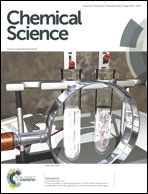Hydrogen-activation mechanism of [Fe] hydrogenase revealed by multi-scale modeling†
Abstract
When investigating the mode of hydrogen activation by [Fe] hydrogenases, not only is the chemical reactivity at the active site of importance but also the large-scale conformational change between the so-called open and closed conformations, which leads to a special spatial arrangement of substrate and iron cofactor. To study H2 activation, a complete model of the solvated and cofactor-bound enzyme in complex with the substrate methenyl-H4MPT+ was constructed. Both the closed and open conformations were simulated with classical molecular dynamics on the 100 ns time scale. Quantum-mechanics/molecular-mechanics (QM/MM) calculations on snapshots then revealed the features of the active site that enable the facile H2 cleavage. The hydroxyl group of the pyridinol ligand can easily be deprotonated. With the deprotonated hydroxyl group and the structural arrangement in the closed conformation, H2 coordinated to the Fe center is subject to an ionic and orbital push–pull effect and can be rapidly cleaved with a concerted hydride transfer to methenyl-H4MPT+. An intermediary hydride species is not formed.
![Graphical abstract: Hydrogen-activation mechanism of [Fe] hydrogenase revealed by multi-scale modeling](/en/Image/Get?imageInfo.ImageType=GA&imageInfo.ImageIdentifier.ManuscriptID=C4SC01605J&imageInfo.ImageIdentifier.Year=2014)

 Please wait while we load your content...
Please wait while we load your content...